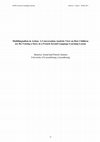Conference proceedings by Beatrice Arend
ICLS 2018, 2018
ORBIT implements and studies a joint problem-solving activity at a tabletop tangible user interfa... more ORBIT implements and studies a joint problem-solving activity at a tabletop tangible user interface (TUI) providing participants with the opportunity to develop their collaboration methods through jointly overcoming breakdowns. The design and the research process relies on user-centered design methods and on an ethnomethodological conversation analytic framework. The project will both generate scientific knowledge on participants' collaboration methods and create a powerful TUI-mediated collaborative learning tool.
Over the past decades, dialogic classroom talk has increasingly been acknowledged to be of prime ... more Over the past decades, dialogic classroom talk has increasingly been acknowledged to be of prime importance for teaching and learning. Many researchers refer to the writings of Mikhail Bakhtin when conceptualising ‘dialogic’ or ‘dialogism’, either as an epistemology or an ontology. In our study we rely on an ontological view of ‘dialogue’ and on the distinction drawn by Bakhtin between ‘authoritative’ and ‘internally persuasive word’ to conduct a sequential analysis (informed by CA) of an extract taken from the film ‘The Class’. Although, the teacher-student interactions at times appear to be ‘messy’ at first sight, our analysis will show that students’ utterances can be considered as an expansion of the subject matter which is accomplished dialogically with their teacher.
In a single case study, we show how a conversation analysis (CA) approach can shed light onto the... more In a single case study, we show how a conversation analysis (CA) approach can shed light onto the sequential unfolding of human-robot interaction. Relying on video data, we are able to show that CA allows us to investigate the respective turn-taking systems of humans and a NAO robot, thus pointing out relevant differences. Our fine grained video analysis points out occurring breakdowns and their overcoming when humans and a NAO-robot engage in a multimodally uttered multi-party communication during a sports guessing game. Our findings suggest that interdisciplinary work opens up the opportunity to gain new insights into the challenging issues of human robot communication.

This paper is a single case analysis of an occurrence of discovery work accomplished by two unive... more This paper is a single case analysis of an occurrence of discovery work accomplished by two university students who are jointly engaged in a tangible-user-interface-mediated physics problem solving activity. The latter is a computer simulation of a biker’s applied force and work done to the bike in a changeable landscape. Participants are asked to solve several tasks to eventually find out which factors influence the dependent variables “Force on Pedal” and “Work”. By relying on an ethnomethodological conversation analytic framework to conduct a moment-by-moment video based analysis, we highlight how two students accomplish the interactional work of discovering that a specific factor influences one of the target variables. Also, our analysis points to the need of adapting the described activity to support the triggering of episodes in which participants engage in joint reflections and discoveries.

ACTES DU XIVe COLLOQUE INTERNATIONAL AIFREF 2011 - Méthodes de recherche en Education familiale : Enjeux, bénéfices et difficultés, 2013
Dans ce rapport de présentation nous portons le regard méthodologique et déontologique sur des si... more Dans ce rapport de présentation nous portons le regard méthodologique et déontologique sur des situations d’enregistrements vidéographiques réalisés en contexte familial dans le cadre de deux projets de recherche. Nous allons soulever les enjeux et les limites de notre dispositif d’observation mis en place dans ce contexte complexe et sensible. En adoptant une approche relevant de l’ethnométhodologie, nous recourons à l’enregistrement audiovisuel qui nous permet d’appréhender l’observation des interactions sociales en temps réel en préservant la temporalité et la spatialité de l’événement. Or, par le recours à des caméras dans le dispositif d’observation, nous touchons à l’anonymat habituellement visé en sciences humaines et sociales. Ainsi, dans le souci d’une démarche qui se veut la moins invasive possible dans une zone non publique et protégée, il nous est important de nous interroger sur la place de l’instrument (outil) caméra en contexte de recherche familial ; d’autant plus que la construction des observables faite dans une perspective holistique est soumise à un certain nombre d’exigences de qualité. Nous allons aborder la problématique soulevée en nous reportant à des questions méthodologiques et déontologiques surgies lors du recueil d’observables en contexte familial.
Papers in Journals by Beatrice Arend

Advances in Human-Computer Interaction, 2021
To support collaboration, researchers from different fields have proposed the design principles o... more To support collaboration, researchers from different fields have proposed the design principles of shareability (engaging users in shared interactions around the same content) and positive interdependence (distributing roles and information to make users dependent on each other). While, on its own, each principle was shown to successfully support collaboration in different contexts, these principles are also partially conflicting, and their combination creates several design challenges. is paper describes how shareability and positive interdependency were jointly implemented in an interactive tabletop-mediated environment called Orbitia, with the aim of inducing collaboration between three adult participants. We present the design details and rationale behind the proposed application. Furthermore, we describe the results of an empirical evaluation focusing on joint problem-solving efficiency, collaboration styles, participation equity, and perceived collaboration effectiveness.
Multimodal Technologies and Interaction, 2018
In recent years, tangible user interfaces (TUI) have gained in popularity in educational contexts... more In recent years, tangible user interfaces (TUI) have gained in popularity in educational contexts, among others to implement problem-solving and discovery learning science activities. In the context of an interdisciplinary and cross-institutional collaboration, we conducted a multimodal EMCA-based video user study involving a TUI-mediated bicycle mechanics simulation. This article focusses on the discovering work of a group of three students with regard to a particular tangible object (a red button), designed to support participants engagement with the underlying physics aspects and its consequences with regard to their engagement with the targeted mechanics aspects.

Our paper provides an empirically based perspective on the contribution of Conversation Analysis ... more Our paper provides an empirically based perspective on the contribution of Conversation Analysis (CA) to our understanding of children’s second language learning practices in a multilingual classroom setting. While exploring the interactional configuration of a French second language learning activity, we focus our analytic lens on how five children and their teacher rely on multilingual resources (French, German, Luxemburgish, and Portuguese) in order to initiate and to improve the re-voicing of a story in French. Through a moment-by- moment (CA) video based analysis we can show how co-constructing the second language learning object involves various embedded linguistic and interactional competencies. We will point out how the participants engage in the re-voicing activity through their mutual orientation to each other’s language conduct. Effective second language learning becomes possible because the teacher’s student-directed talk provides opportunities for the children to provide oral narratives in a jointly constituted multilingually shaped interaction. Moreover, by offering insights into the interactional features (turn-taking system), CA allows us to visualize how the children’s second language learning practices are interrelated with the sequential structure of multilingual talk-in-interaction. Thus, in our case study we emphasize the fundamentally social nature of second language classroom talk.
This paper discusses theoretical and methodological issues arising from a video based research de... more This paper discusses theoretical and methodological issues arising from a video based research design and the emergent tool Joint Screen when grasping joint activity. We share our reflections regarding the combined reading of four synchronised camera perspectives joint in one screen. By these means we reconstruct and analyse multimodal moment-to-moment interaction between young peers engaged in an open-ended baking activity. We rely on a fine-grained analysis of three multimodally transcribed video extracts to highlight how a combined viewing of multiple joint camera perspectives provides access to how participants do joint activity through the simultaneous and continuous use of embodied resources. We argue that Joint Screen generates an ‘expanded around’ view that allows to seize multimodal interactional processes in their phenomenal depth in time and space.
In this article we demonstrate how a CA based study can shed light on the complex phenomenon of c... more In this article we demonstrate how a CA based study can shed light on the complex phenomenon of classroom talk. Through a fine-grained single case analysis, it turns out that apparently 'disordered' moments in a French high school grammar lesson can be considered as an instance of dialogic teaching. We identify occurring overlaps and students' self-selections as accounts of dialogue promoting joint thinking and learning.
In a single case study, we show how a conversation analysis (CA) approach can shed light onto the... more In a single case study, we show how a conversation analysis (CA) approach can shed light onto the sequential unfolding of human-robot interaction. Relying on video data, we are able to show that CA allows us to investigate the respective turn-taking systems of humans and a NAO robot in their dialogical dynamics, thus pointing out relevant differences. Our fine grained video analysis points out occurring breakdowns and their overcoming, when humans and a NAO-robot engage in a multimodally uttered multi-party communication during a sports guessing game. Our findings suggest that interdisciplinary work opens up the opportunity to gain new insights into the challenging issues of human robot communication in order to provide resources for developing mechanisms that enable complex human-robot interaction (HRI).
Book Chapters by Beatrice Arend
Individuelle Förderung und Lernen in der Gemeinschaft Volume 17 of the series Jahrbuch Grundschulforschung, 2014
Paper presentations by Beatrice Arend

The study relies on the concept of "dialogic teaching" (Alexander 2004, Mercer & Littleton 2007, ... more The study relies on the concept of "dialogic teaching" (Alexander 2004, Mercer & Littleton 2007, Reznitskaya, 2012) in order to rethink classroom interactions that appear to be “messy” at first sight. To do so a video sequence is taken from the film “Entre les murs” (Cantet, 2008) that is based on François Bégaudeau’s semi-autobiographical novel of the same name. A fine-grained analysis of teacher-student interactions is conducted according to an ethnomethodologically and conversation analytic inspired approach (see e.g. Psathas, 1995). The results of this analysis and the reference to “dialogic teaching” open up a new perspective on the event, i.e. it becomes possible to consider students’ utterances not as digression but ass enriching contributions to an expansion of the learning/teaching object. Teachers can rely on the conducted analysis and the findings to develop their analytical stance and to reflect on their own classroom practice. Furthermore, the study can inspire docents to rely on video sequences in a similar way during their seminars.
References:
• Alexander, R. (2004) Towards Dialogic Teaching: Rethinking Classroom Talk, Cambridge: Dialogos.
• Bégaudeau, F. (2006). Entre les murs. Paris: Éditions Verticales.
• Cantet, L. (2008). Entre les murs [Motion picture]. Haut et Court.
• Mercer, N. & Littleton, K. (2007). Dialogue and the Development of Children’s Thinking. A sociocultural approach. Oxon, New York: Routledge.
• Psathas, G. (1995). Conversation Analysis. Thousand Oaks, London & New Delhi: Sage
• Reznitskaya, A. (2012). Dialogic Teaching. Rethinking Language Use During Literature Discussions. The Reading Teacher, 65(7). 446-456.
• Vygotsky, L.S. (1978). Mind in Society. The Development of Higher Psychological Processes. Cambridge, Massachusetts; London, England: Harvard University Press.
Papers by Beatrice Arend
IAFOR journal of language learning, Jan 19, 2018
EDULEARN proceedings, Mar 1, 2017
Springer eBooks, Dec 10, 2013
Im Zuge der Diskussion um die Bedeutung von (fruh)kindlichen Bildungs- und Lernprozessen ruckt di... more Im Zuge der Diskussion um die Bedeutung von (fruh)kindlichen Bildungs- und Lernprozessen ruckt die Frage der Beobachtbarkeit des Lernensin den Blickpunkt der grundschul- und elementarpadagogischen Forschung. Um Lernensichtbar werden zu lassen, braucht es die Entwicklung einer methodischen Strategie und einen theoretischen Rahmen fur dessen Beschreibung und Analyse (vgl. Wiesemann 2006, 175). Das hier vorgestellte und laufende qualitative Forschungsprojekt „CoLeaP – Collaborative Learning among Peers“ (Sunnen/Arend/Fixmer 2010) zielt darauf ab, sich gemeinsam konstruierten Lernprozessen von Kindern anzunahern und somit in der Diskussion um die Beobachtbarkeit von Lerneneinen Beitrag zu leisten.
Classroom discourse, Dec 20, 2013











Uploads
Conference proceedings by Beatrice Arend
Papers in Journals by Beatrice Arend
Book Chapters by Beatrice Arend
Paper presentations by Beatrice Arend
References:
• Alexander, R. (2004) Towards Dialogic Teaching: Rethinking Classroom Talk, Cambridge: Dialogos.
• Bégaudeau, F. (2006). Entre les murs. Paris: Éditions Verticales.
• Cantet, L. (2008). Entre les murs [Motion picture]. Haut et Court.
• Mercer, N. & Littleton, K. (2007). Dialogue and the Development of Children’s Thinking. A sociocultural approach. Oxon, New York: Routledge.
• Psathas, G. (1995). Conversation Analysis. Thousand Oaks, London & New Delhi: Sage
• Reznitskaya, A. (2012). Dialogic Teaching. Rethinking Language Use During Literature Discussions. The Reading Teacher, 65(7). 446-456.
• Vygotsky, L.S. (1978). Mind in Society. The Development of Higher Psychological Processes. Cambridge, Massachusetts; London, England: Harvard University Press.
Papers by Beatrice Arend
References:
• Alexander, R. (2004) Towards Dialogic Teaching: Rethinking Classroom Talk, Cambridge: Dialogos.
• Bégaudeau, F. (2006). Entre les murs. Paris: Éditions Verticales.
• Cantet, L. (2008). Entre les murs [Motion picture]. Haut et Court.
• Mercer, N. & Littleton, K. (2007). Dialogue and the Development of Children’s Thinking. A sociocultural approach. Oxon, New York: Routledge.
• Psathas, G. (1995). Conversation Analysis. Thousand Oaks, London & New Delhi: Sage
• Reznitskaya, A. (2012). Dialogic Teaching. Rethinking Language Use During Literature Discussions. The Reading Teacher, 65(7). 446-456.
• Vygotsky, L.S. (1978). Mind in Society. The Development of Higher Psychological Processes. Cambridge, Massachusetts; London, England: Harvard University Press.